
Drive sales on autopilot with ecommerce-focused features
See FeaturesBuilding an email list is crucial for businesses as it remains the most profitable marketing channel you control, offering unmatched ROI compared to social media and ads.
Automated emails account for 37% of all email-generated sales, highlighting the effectiveness of permission-based communication in driving revenue.
Instead of buying email lists, focus on organic growth strategies, such as offering valuable lead magnets and utilizing multiple channels to invite subscribers.
A healthy email list requires ongoing management, including segmentation, regular cleaning, and compliance with laws to ensure deliverability and engagement.
While social media algorithms shift overnight and ad costs soar, building an email list remains the most profitable marketing channel you control.
According to our internal data, automated emails now drive 37% of all email-generated sales despite making up only 2% of total sends.
That kind of ROI is hard to ignore. Yet many businesses treat list building as an afterthought, losing out on easy revenue. Meanwhile, organic social reach is plummeting, ad costs are surging, and privacy changes are rewriting the rules.
This guide is a complete, actionable blueprint for list building. You’ll learn everything from how to create an email list from scratch to the advanced email list-building strategies top brands use.
Quick sign up | No credit card required
What is an email list?
An email list, also known as a mailing list or subscriber list, is a collection of email addresses from individuals who wish to receive communications from your business.
These contacts have opted in and given explicit permission to receive updates, offers, or content. Most subscribers join through a signup form, a popup, or a checkout box.
Here’s an example of an email list on Omnisend:

Unlike social media followers, an email list is an asset you truly own. Social platforms can modify their algorithms, limit your reach, or even suspend accounts without prior notice. With a mailing list, you control the communication.
This direct access allows stronger personalization, segmentation, and long-term relationship building.
Pat Flynn of Smart Passive Income puts it best: “Your email list is your own.” It’s not rented, borrowed, or at risk of disappearing overnight. Remember, however, that the key is consent.
What an email list is not
Before we go into details, here’s what an email list isn’t:
- A list of contacts you purchased or scraped. Non-permission-based contacts violate anti-spam laws and the terms of email service providers (ESPs). They’ll tank your deliverability and damage your sender reputation.
- Your personal Gmail or Outlook contact book. Personal email clients lack the infrastructure for compliant mass email marketing. You need proper unsubscribe mechanisms, analytics, and deliverability tools.
- Your list of social media followers. That audience is rented and controlled by algorithms.
- A static spreadsheet. A healthy list needs ongoing management, segmentation, and cleaning to stay effective.
“Your email list is the only marketing channel where you set the rules. No algorithm changes or no ad auction wars. Just you, your message, and people who chose to listen.”
— Evaldas Mockus, VP of Marketing at Omnisend
The great debate: Buying email lists vs. building them
Many new marketers wonder if they can simply buy an email list and skip the slow process of growing one organically. It sounds efficient, but in practice, it rarely works.
The “shortcut” temptation: Why people buy lists
Buying a list can feel like the quickest way to get “targeted databases” or “ready-made audiences.” Even reputable data providers, such as UpLead and Cognism, sell verified emails for B2B sales outreach.
But those lists are meant for B2B cold outreach, not for B2C or ecommerce marketing. For consumer brands, buying email lists is a shortcut that leads to legal and technical failure.
The dangers of purchased consumer email lists
To be clear, you should never buy consumer email lists. Here’s why:
- Violation of ESP terms of service: Permission-based platforms, like Omnisend, strictly forbid purchased, rented, or third-party lists in their Terms of Use
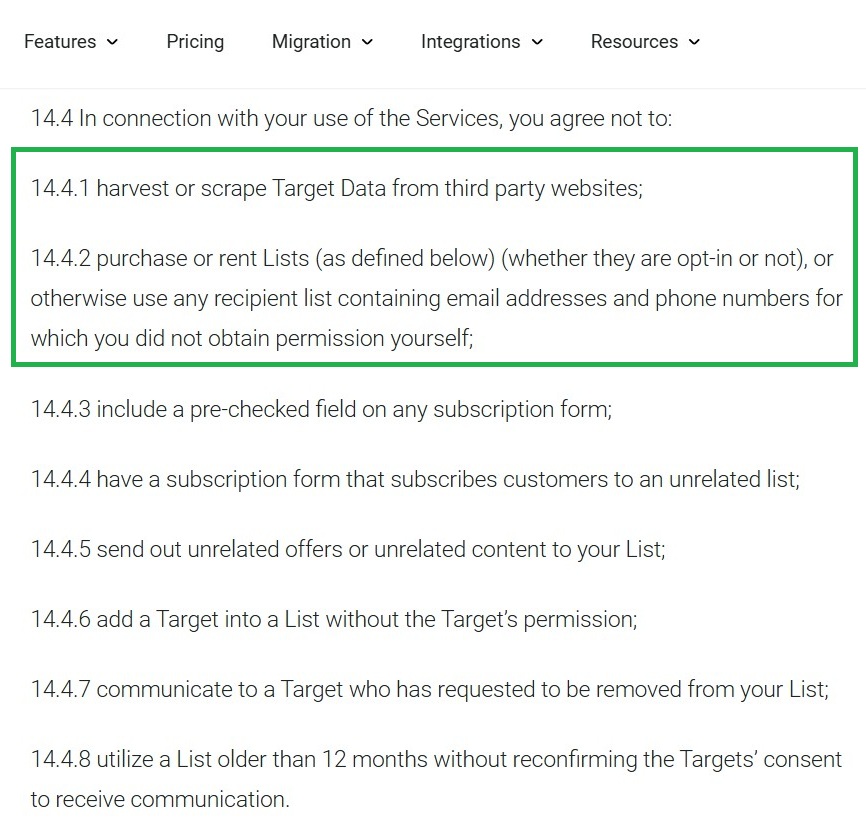
- Catastrophic technical risks: Bought lists are packed with fake emails, outdated addresses, or spam traps, and hitting one can get your domain blocked or blacklisted
- Legal and compliance risks: You can’t prove consent, which puts you at risk under laws like GDPR and CAN-SPAM
- Financial waste and reputational damage: Random contacts in email lists can lead to high bounce rates, low engagement, and spam complaints that ruin your sender reputation
- Account termination: Uploading purchased contacts can trigger immediate suspension, as mentioned in Omnisend’s compliance policy

The alternative: How to build an “owned” asset
Instead of buying 10,000 cold contacts who’ll never engage, focus on earning 100 subscribers who actually want your emails.
Omnisend data shows that one in two people who click automated welcome or cart-recovery emails convert, proving that consent-driven lists convert.
The fix: Never buy contacts. Focus on organic list-building methods instead.
Need leads faster? Invest in ads that drive traffic to your opt-in forms. You’ll pay for reach, but you’ll earn genuine permission.
Why an email list is your most valuable marketing asset
Few marketing channels deliver the power, predictability, and profit of email. Omnisend customers earn $68 for every $1 spent, a return that’s unmatched by any ad platform or social network.
Unlike algorithm-driven platforms, an email list is entirely yours. It’s a direct, permission-based channel where you decide the message, timing, and audience.
This ownership unlocks deep personalization. Because you own the data, you can segment by behavior, purchase history, interests, and preferences.
Reasons your email list outperforms every other channel
Here are five reasons your email list outperforms every other marketing channel:
- Unmatched ROI and direct revenue: Email drives measurable results that few channels can rival. Ecommerce brand Dukier grew revenue by 525% with Omnisend, while Vyber Media scaled a client to $1.5M in annual sales through strategic email marketing.
- Complete ownership and control: Your email list is a business asset you own outright, not a borrowed audience. Salomon Japan proves this, engaging more than 130,000 subscribers directly, while safe from algorithm swings or “pay-to-play” shifts.
- Robust and scalable automation: Automations run around the clock, driving 37% of all email sales from just 2% of sends, with a +2361% higher conversion rate than manual campaigns. Bowy Made turned pre-purchase automations into a steady five-figure revenue engine.
- High-intent conversion: Subscribers opt in, so they’re more likely to buy. One in every two people who clicked an automated welcome or cart email makes a purchase. Gamehide converts 7.7% of new subscribers into buyers.
- Deep personalization and engagement: Owning your list enables you to segment your audience by behavior, interests, and purchase history. Salomon Japan maintains a 45% open rate, while AcreValue grew engagement from 5% to 70% by improving list health and targeting.
Social vs. Email: Awareness vs. Action
Social media works best for discovery. It builds awareness and community, but it’s crowded and full of distractions.
Email, in contrast, reaches people in a decision-ready space: their inbox. It’s where attention is focused and action happens.
The bottom line
Given its ROI, control, and conversion power, your email list is your most valuable marketing asset. It’s what turned Headbanger Sports into a $1.5M success story through consistent, owned list growth.
Now that you understand why your email list matters, we’ll explain how to build an email list from scratch.
How to build an email list from scratch
Building an email list can feel overwhelming, but it becomes simple when you follow clear, step-by-step instructions.
- Choose an email service provider (ESP) that fits your business needs
- Create compelling signup forms that capture attention and convert visitors
- Offer something valuable (a lead magnet) in exchange for email addresses
- Start inviting people through multiple channels and touchpoints
Step 1: Choose a platform (ESP)
A strong email list starts with the right email service provider (ESP). You need a platform that stores contacts, sends targeted campaigns, automates messages, and ensures compliance.
Avoid using your personal Gmail or Outlook email account when managing email lists for marketing. These platforms often lack essential features such as unsubscribe links, segmentation, analytics, and contact management. They also have strict sending limits and no deliverability protection, making them risky and unsuitable for business use.
A dedicated mailing list service handles all this for you. It manages opt-ins, automatically handles unsubscribes, supports automation, and protects your deliverability.
Many platforms even offer free plans, letting you learn how to build an email list for ecommerce, affiliate marketing, or personal projects without upfront costs.
Your ESP should:
- Have simple navigation with easy-to-use drag-and-drop tools
- Be scalable as your email list grows
- Support email and SMS automation
- Segment based on behavior or interests
- Integrate smoothly with your ecommerce or website
- Have free plans for the trail and affordability
Many free email marketing platforms, such as Omnisend and Mailchimp, include forms, basic automation, and a sufficient number of monthly sends to get started for free.
What is the best free mailing list service?
A good free plan should let you grow your list without forcing an early upgrade. Look for generous subscriber limits, sufficient monthly sending capacity, and access to key features such as forms, landing pages, and basic automation.
Here’s how the top free plans compare:
| Mailing list service | Free subscriber limit | Free email send limit | Key list-building features (on free plan) | Pricing (starts at) | Best for |
|---|---|---|---|---|---|
| Omnisend | 250 | 500/month | Signup forms, advanced automation, segmentation, SMS popups, | $16/month | Ecommerce stores |
| Mailchimp | 500 | 500/day (or 1k/month) | Basic forms and templates, limited automation | $13/month | Creators needing simple tools |
| MailerLite | 500 | 12,000/month | Signup forms, landing pages, basic automation | $10/month | Bloggers, content creators |
| Klaviyo | 250 | 500/month | Forms, segmentation, basic analytics | $20/month | Direct-to-consumer brands |
| Brevo (formerly Sendinblue) | Unlimited | 300/day (~9k/month) | Forms and email templates, SMS, marketing automation | $9/month | SMEs |
“After exploring the platform and working with Omnisend’s customer support team, I quickly realized this could be a game-changer for our clients. That initial client account became one of our top-performing lifecycle marketing success stories, generating over $1.5M in annual revenue and growing its audience by 100,000 email subscribers and 40,000 SMS subscribers.”
— Jesse Kay, Founder and CEO Vyber Media
Step 2: Create a signup form
Your signup form is the gateway to your email list. It needs to be visible, simple, and compelling enough to convert visitors into subscribers.
Most people see it for only a few seconds, so every detail matters. Here are some key best practices to keep in mind:
- Clear value proposition: Tell people exactly what they get. “Get 15% off your first order” is more effective than “Join our newsletter.”
- Minimal fields: Ask only for essential info, usually just the email. Optional fields can reduce conversions.
- Strategic placement: Place your forms on the header, footer, sidebar, and as a timed popup. Use multiple form types working together.
- A/B test: Experiment with different headlines, visuals, and timing (instant vs. delayed popup). Continuous A/B testing helps you discover what converts best.
- Double opt-in: Consider requiring subscribers to confirm their email via a link. With double opt-in, you maintain a high-quality, compliant, and engaged list.
- Mobile optimization: A significant portion of signups occurs on phones. Ensure your forms are responsive and easy to complete on mobile devices.
- Visual impact: Wisepops data shows popups with images converted at 5.46%, compared to 3.22% without images — evidently, design matters.
Let’s summarize the most popular signup form types and their respective uses.
| Form type | What it is | Best for | Pro tip |
|---|---|---|---|
| Embedded form | Static form built into the page layout (header, footer, sidebar) of high-traffic pages or blog posts | Always-on collection. Steady, passive list growth | Keep fields minimal to avoid friction, and use alongside popups for visitors who dismiss overlays |
| Timed/scroll-based popup | Appears after the visitor spends a set time on the site or scrolls | Engaging interested visitors who’ve browsed content | Delay 15-30 seconds (or 25% depth) to avoid annoying visitors |
| Exit-intent popup | Appears when a visitor is about to leave | Saving abandoning visitors | Offer a small incentive to prevent bounce |
| Slide-in/flyout | Slides in from the side or corner of the screen | Less intrusive than full popups. Good for mid-scroll engagement | Great for mobile, where full popups feel overwhelming |
| Announcement/sticky bar | Narrow bar/banner pinned to the top/bottom of the page | Non-intrusive, site-wide visibility without interruption | Use contrasting colors to highlight your most valuable lead magnet |
| Landing page form | Dedicated standalone signup page | Paid ad campaigns/promotions. Focused conversion goals | Keep the page distraction-free for maximum conversions |
| Gamified form | Interactive forms with a fun reward element | Driving engagement. Creating excitement around signup | Use sparingly so it feels special, not gimmicky |
| Checkout/cart opt-in | Checkbox/field in the checkout page | Converting buyers into subscribers at the point of purchase | Make opt-in default unchecked to follow compliance rules |
| Teaser widget | Small tab expanding into a complete form when clicked | Providing an opt-in option without interrupting browsing | Use a clear CTA like “Get 10% Off” to get more clicks |
Step 3: Offer something valuable (Lead Magnet)
To grow your list, you need to offer real value, and that is a lead magnet with valuable incentives offered in exchange for email permission.
A good lead magnet should solve a real problem or fulfill a genuine desire. Generic “subscribe to our newsletter” buttons no longer suffice.
Here are proven lead magnet ideas:
- Discounts or perks for ecommerce: Can include a percentage off the first order, free shipping, loyalty points, or early access to new products
- Content upgrades for creators: Can include exclusive ebooks, templates, cheat sheets, free email courses, or webinar access
- Exclusive access: Can include member-only content, VIP sales, private community invitations, and early product launches
Your lead magnet must align with your audience’s interests.
A fitness brand might offer a workout guide, while a blog or affiliate site could offer a curated resource list. The more specific your offer, the more qualified and engaged your subscribers will be.
For example, someone who downloads a “Complete Guide to Indoor Plant Care” is more likely to engage with emails about your plant shop than a generic discount seeker.
Remember, whatever you offer, it must be in exchange for explicit permission to email. Make that value exchange clear to comply with laws like GDPR and CAN-SPAM.
Step 4: Start inviting people
Once your signup form and lead magnet are ready, it’s time to invite people to join your email list for marketing. Promotion is essential as your list won’t grow if no one knows it exists.
Start by strategically leveraging the channels you already use:
- Website and blog: Add clear calls to action throughout your site. End blog posts with prompts like, “Enjoying this content? Subscribe for weekly tips.” Embed forms in headers, footers, and sidebars for constant visibility.
- Personal outreach: Invite current customers during checkout or via follow-up emails. Warm contacts who already know your brand are among the best ways to grow a list.
- Social media: Share your signup offer in bios and posts. A simple “Subscribe for exclusive updates” link in an Instagram bio or pinned tweet can drive signups. Highlight what subscribers gain and link to your landing page.
- Offline opportunities: If you run a physical store or attend events, collect emails using iPads, QR codes, or a simple landing page. This also addresses those wondering how to build an email list without a website.
- Paid advertising: If your budget allows, run targeted ads to your signup page. Pay for reach, not purchased contacts, which violates ESP terms and laws.
Remember, quality always beats quantity. Since your goal is permission-based growth, you should never buy email lists to inflate your numbers.
These contacts haven’t opted in, resulting in poor engagement, compliance risks, and wasted resources. Purchased lists also hurt deliverability and damage the sender’s reputation. Even though you start with zero, these steps will help you build an engaged email list quickly.
6 proven strategies to build your email list
With your email list set up, it’s time to grow it. The following strategies have been shown to consistently drive email list growth across various industries and business sizes:
- Exit-intent or timed popups
- Content marketing and SEO
- Embedded signup forms
- Post-purchase email opt-ins
- Social media → email conversion
- SMS-to-email flows
Let’s break down exactly how to implement each one.
1. Exit-intent or timed popups
When implemented thoughtfully, popup forms can be one of the most effective ways to grow your email list.
Exit-intent popups appear as a visitor shows signs of leaving, while timed popups appear after a set number of seconds, and on-scroll popups trigger when a user reaches a certain point in the scroll. These behavior settings provide multiple opportunities to capture a visitor’s attention before they leave.
Data shows well-designed popups with compelling offers can achieve conversion rates exceeding 3%, with top performers reaching over 9%.
Make your popups worth it by adding some tangible value and not just generic, no-incentive options
Omnisend users often see strong growth with gamified popups like Wheel of Fortune opt-ins, making subscribing feel like a win:

You can also experiment with popup surveys: Ask a quick question first, then reveal a tailored offer and email field. It increases engagement, collects segmentation data, and makes the request feel more personalized.
2. Content marketing and SEO
High-quality content consistently drives email list growth. Blog posts, guides, tutorials, and comparison articles attract visitors through search and provide natural spots for embedded signup forms, inline CTAs, or contextual opt-ins.
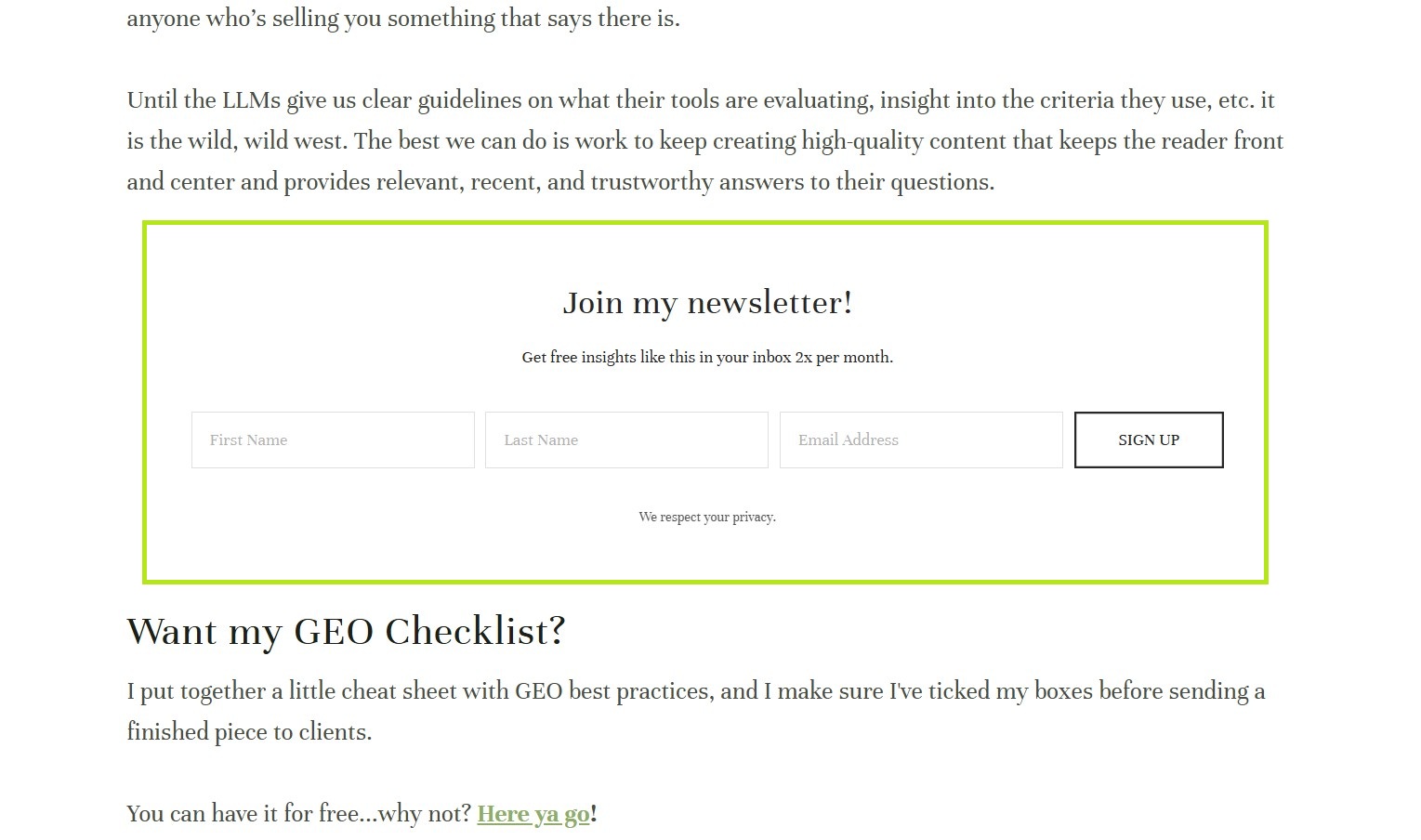
Webinars, live workshops, and virtual events also act as effective lead magnets because people subscribe when content solves real problems or teaches valuable skills.
Your content should solve real problems or fulfill genuine desires. When people trust your expertise, they’ll want more, and subscribing becomes the natural next step.
3. Embedded signup forms
Embedded forms integrate seamlessly within your site, capturing subscribers without interrupting the browsing experience.
Unlike popups, they’re passive but always visible, quietly converting visitors who might ignore intrusive prompts. Strategic placement is key:
- Footer forms work well for engaged readers who’ve scrolled through your content
- Product page forms appeal to those showing high purchase intent
- Sidebar forms stay visible while visitors explore
You can also embed forms on high-traffic pages, such as your homepage or blog articles. For advanced list building, Omnisend offers multi-step signup forms.
These break the process into stages, asking for an email first and then additional details later. This approach gathers richer subscriber data without overwhelming users upfront, thereby improving conversion while maintaining a smooth experience.
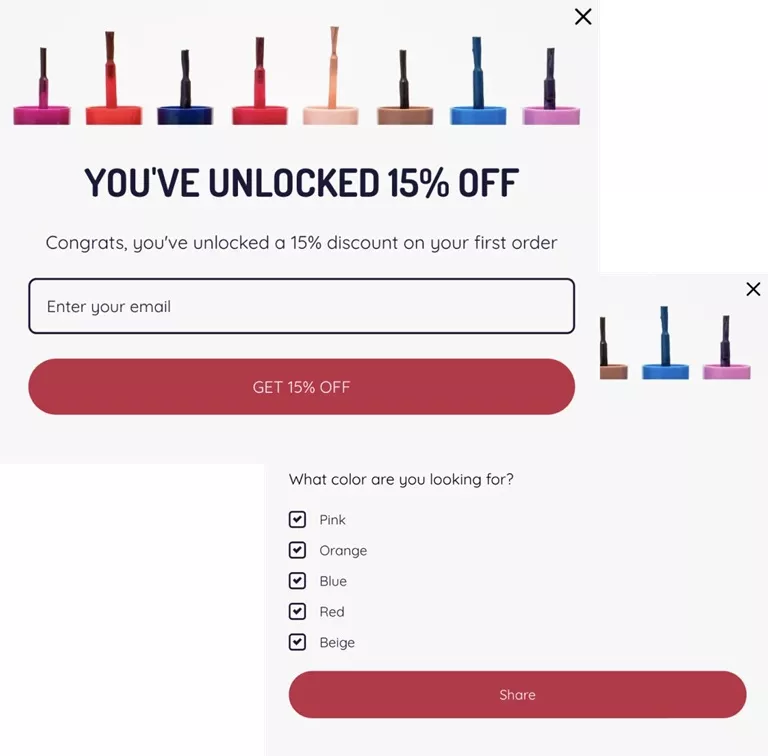
4. Post-purchase email opt-ins
After a customer makes a purchase, their trust is at its peak, making this an ideal moment to invite them to join your list.
For ecommerce, add an opt-in checkbox at checkout or a form/popup on the thank-you page. Keep the checkbox unchecked by default to stay compliant.
If they don’t subscribe immediately, send a follow-up “thank you” email with a clear CTA for updates, tips, or exclusive offers.
Offline, you can capture emails in physical stores or events using tablets, QR codes, or digital forms at checkout. This poster by Forgotten Felines & Fidos demonstrates how it can be done.

5. Social media → email conversion
One of the easiest ways to convert them is through a dedicated landing page signup form. Omnisend’s landing pages are simple, shareable, and perfect for your Instagram bio, TikTok profile link, YouTube description, or Facebook CTA button.
Run social-only giveaways or contests requiring an email to enter. Select prizes that are relevant to your ideal audience to attract high-quality subscribers, not freebie seekers. Also, encourage referrals by rewarding subscribers who invite friends.
You can also tease a valuable insight from your latest newsletter in a post and invite followers to join your list for the whole story. This frames email as the place for deeper, premium content.
For maximum effect, utilize platform features such as “link in bio,” Instagram Stories swipe-ups, YouTube end screens, and pinned posts. These can help promote your signup offers or guide followers to your signup page.
Here’s a video tutorial on converting social followers to email subscribers for step-by-step strategies:
6. SMS-to-email flows
SMS has incredibly high open rates, which makes it a strong channel for cross-promoting your email list.
Start by collecting SMS subscribers through website prompts, checkout opt-ins, or in-store signups. Then, send targeted text campaigns inviting them to join your email list for complementary benefits.
SMS delivers immediate, time-sensitive alerts, including flash sales, restocks, and limited-time offers. Email provides in-depth content, detailed product stories, and significant announcements.
When subscribers see unique value in both channels, they’re more likely to opt in.
Here’s an Omnisend sample SMS layout promoting a Black Friday sale:

What a healthy email list looks like
Many marketers fixate on how to grow their email list fast, but size alone doesn’t determine success. A truly valuable email list combines quality, engagement, and relevance, not just quantity.
Maintaining a healthy list requires ongoing attention to these key areas:
- Welcome flows that set expectations
- Engagement segmentation for targeted messaging
- Regular list cleaning to remove dead weight
- Compliance habits that maintain list integrity
Let’s explore each.
Welcome flows that set expectations
The first emails your subscribers receive set the tone for your entire relationship. Effective welcome sequences deliver promised incentives, explain what to expect, and start building trust.
Omnisend’s ecommerce research shows that welcome emails achieve an open rate of about 35% and a CTR of over 58%, the highest of any other automated email flows:
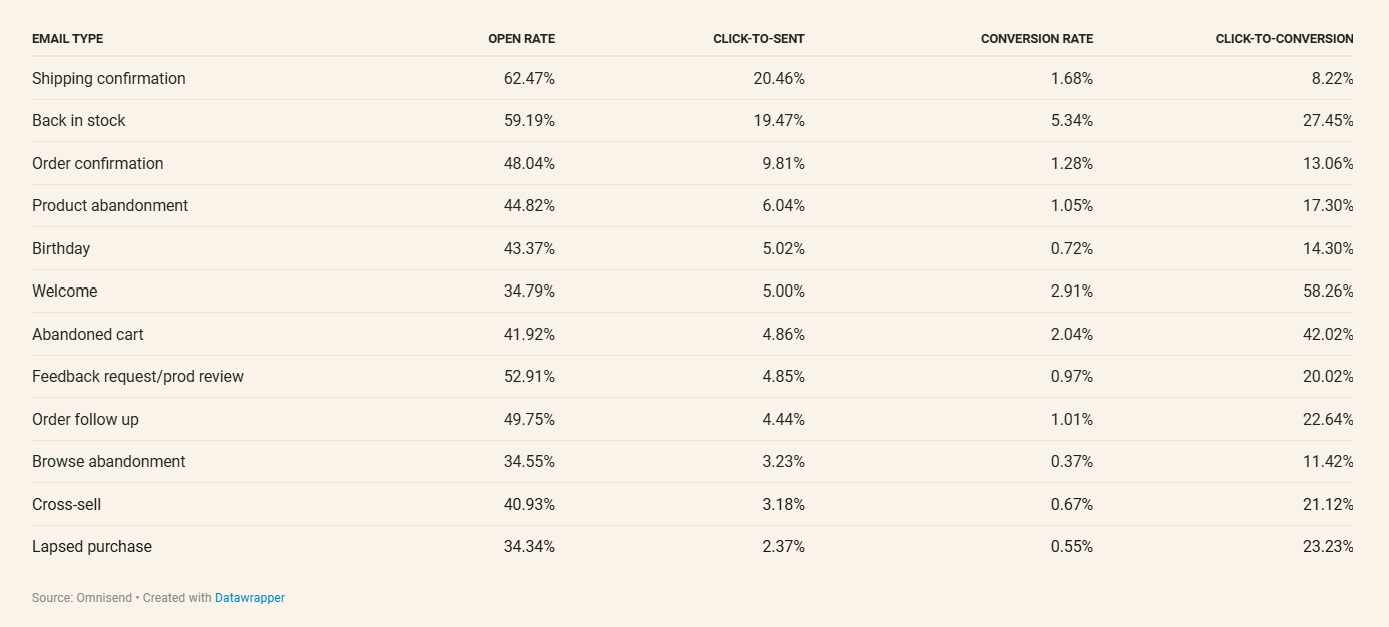
These metrics show that welcome emails are a great way to make a strong first impression and begin segmenting subscribers based on their interests.
 | “Automating our welcome series has been key to sharing our brand story effectively. We’ve been able to showcase diverse perspectives — from our founder to our farmers, allowing us to connect with subscribers on a deeper level and highlight what makes us unique. This personalized approach, enabled by email automation, strengthens customer relationships, even with our small team.” James Le Compte, CEO at To’ak Chocolate To’ak’s welcome series has a 47% open rate and 18% conversion rate. Read the full case study here. |
Engagement segmentation for targeted messaging
Segmentation divides your list into groups of similar subscribers so you can send more relevant content.
Basic segmentation might separate active versus inactive subscribers, while advanced strategies might incorporate purchase history, browsing behavior, and demographic information.

Email marketing research consistently shows that targeted, relevant messaging outperforms generic broadcasts.
Omnisend’s email automation tools make it possible to create these segments automatically based on subscriber behavior. Here’s a look at a dashboard sample of Omnisend’s pre-built segments.
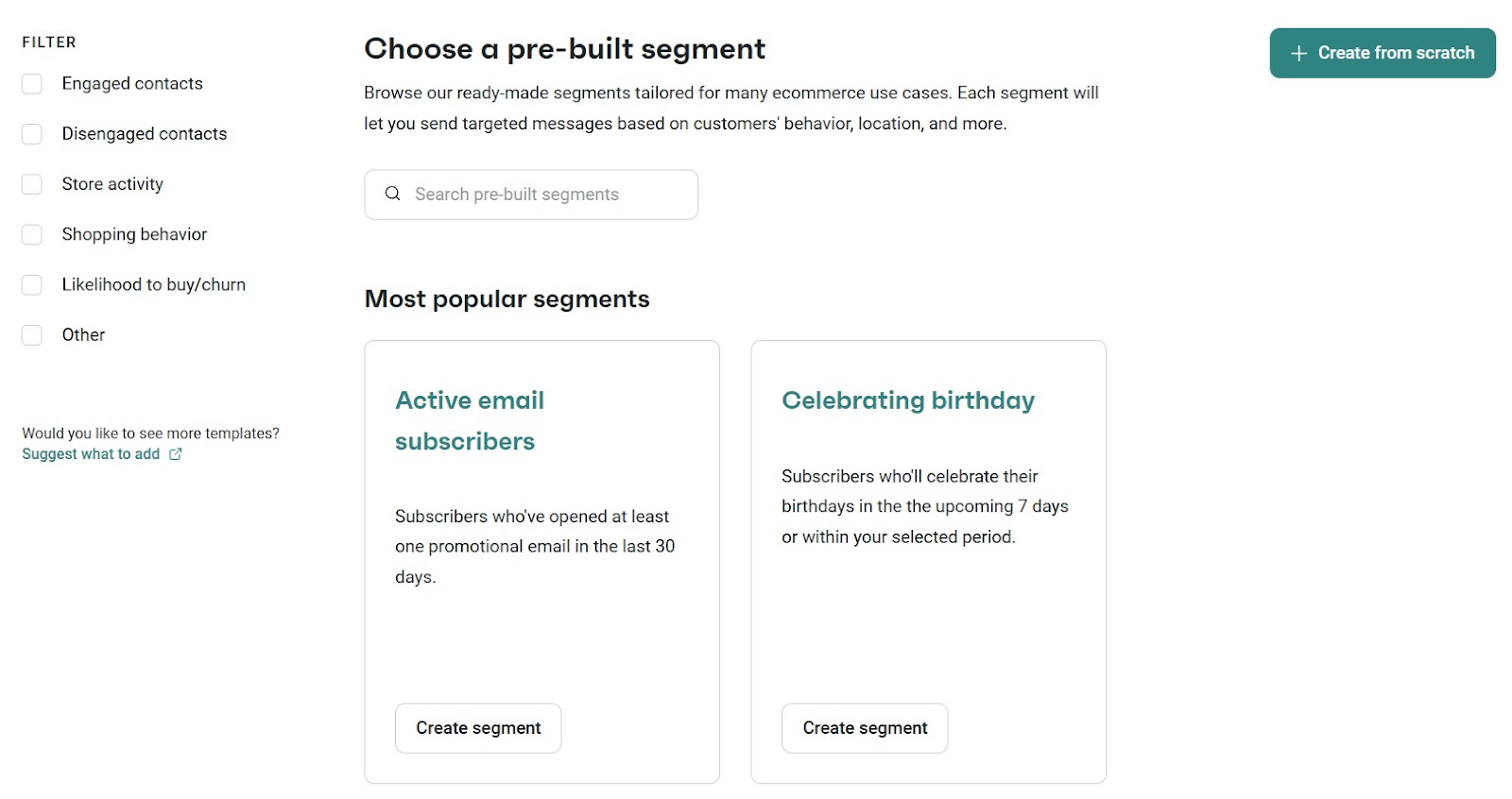
Regular list cleaning to remove dead weight
Removing unengaged subscribers may feel counterproductive, but it’s essential for list health. Subscribers who haven’t opened your emails in six to 12 months drag down your performance metrics and increase your costs.
More importantly, email service providers use engagement rates to decide whether your emails land in inboxes or spam folders, so inactive subscribers can drag down performance for your engaged audience.
A healthy email list is dynamic and requires ongoing attention. The effort you invest in maintaining list health pays dividends through improved deliverability, engagement, and, ultimately, conversions.
Looking at this dashboard, you can see how effectively Omnisend cleans your email list:
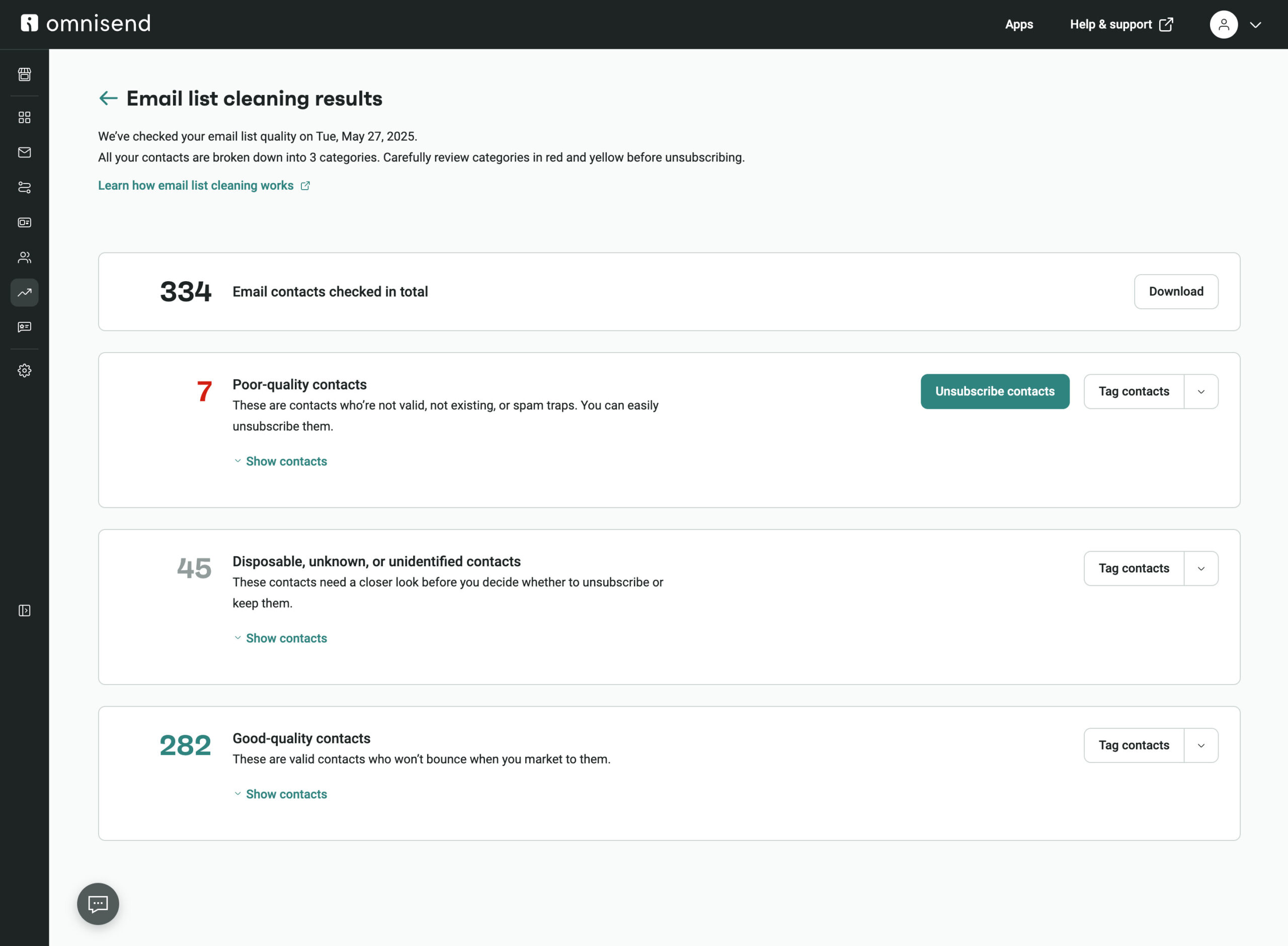
Here’s a video tutorial on how to quickly clean your email list:
Compliance habits that maintain list integrity
A healthy email list is 100% opt-in and fully compliant with laws like CAN-SPAM and GDPR. Every subscriber should’ve explicitly opted in.
Purchased or scraped contacts, such as those from a buy email list database, will only damage your deliverability, engagement, and sender reputation.
Beyond compliance, closely monitor unsubscribe and spam complaint rates. Spikes signal you’re emailing uninterested recipients, which erodes trust.
Using reputable email service providers or ethical list-building methods ensures your growth remains sustainable and legally safe.
In short, a compliant, consent-driven list protects your business. It also helps establish long-term subscriber satisfaction and an effective email list for marketing success.
Email list mistakes that cost you growth
Even experienced marketers make mistakes that limit the potential of their email list. Here’s how to avoid the most common email list mistakes — and what to do instead:
- Neglecting mobile optimization
Many signup forms look fine on desktop but break on mobile. Since most people check email on their phones, about 70% of them, if we go by the stats, mobile-unfriendly forms instantly reduce conversions. Test each form across devices, ensure buttons are tappable, and use responsive designs.
- Asking for too much information upfront
Extra fields lower signup rates. Start with just an email address and gather more info later. Omnisend’s prebuilt templates make it easy to launch high-converting, minimal forms without extra work.
- Hiding your signup forms
If visitors can’t easily spot your opt-in, they won’t subscribe. Use multiple placements, including headers, footers, blog posts, and product pages. You can also highlight forms with contrasting colors and compelling CTA.
- Skipping the double opt-in process
Without verification, spam bots, typos, and low-quality addresses may creep in. Double opt-in protects deliverability, ensures GDPR compliance, and attracts genuinely engaged subscribers. - Forgetting to set expectations
Subscribers who don’t know what to expect are more likely to unsubscribe or mark emails as spam. Clearly state what you’ll send and how often on the form, thank-you page, and in your welcome email. - Purchasing email lists
Purchased lists can hurt deliverability, include outdated or spam-trap emails, and rarely lead to genuine engagement. Organic list-building is always the more sustainable, brand-safe approach. - Ignoring email list hygiene
Failing to clean your list results in higher bounce rates and lower sender reputation. Regularly remove inactive or invalid contacts to maintain strong performance.
Ready to own your audience?
Building an email list is a long-term investment in your business. Unlike social media, which can change overnight, a permission-based list is an asset that continues to pay off.
A small, engaged audience will consistently outperform an extensive list of passive contacts, so focus on people who actually engage and not just numbers. Whether you have 10 subscribers or 10,000, deliver value consistently.
If you’re ready to put these strategies into action, Omnisend brings everything together, from high-converting signup forms to automated welcome flows and list-cleaning tools. The all-in-one, beginner-friendly platform helps you own your audience and grow smarter.
Quick sign up | No credit card required
FAQs
An email list is a collection of subscriber email addresses that you own, allowing you to reach and market directly without relying on social media algorithms.
You create an email list by offering signup forms, popups, or lead magnets, collecting permission-based subscribers, and growing it with consistent value-driven content and automated workflows.
No. Buying an email list can harm deliverability, include unengaged or fake contacts, increase spam complaints, and rarely yield results. Building an organic, opt-in list is always more effective.
Buying an email list can be a legal but risky endeavor. Many regions require consent-based contacts, and sending to purchased lists can violate GDPR, CAN-SPAM, and platform terms.
The best free mailing list service depends on your needs. Many choose Omnisend’s free plan for its email list growth tools, automation, and signup forms, all in one platform.
The value of a 10,000-person email list depends on engagement. With email’s average $68 return per $1 spent, according to Omnisend’s US data, a highly engaged list can be profitable.
TABLE OF CONTENTS
TABLE OF CONTENTS


No fluff, no spam, no corporate filler. Just a friendly letter, twice a month.

 OFFER
OFFER









